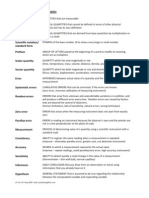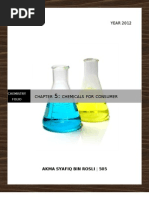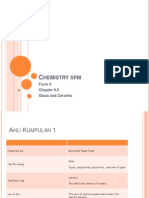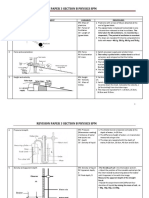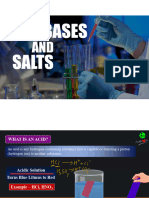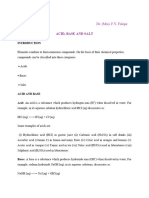Acids, Bases and Salts
Acids, Bases and Salts
Uploaded by
shehryar khanCopyright:
Available Formats
Acids, Bases and Salts
Acids, Bases and Salts
Uploaded by
shehryar khanCopyright
Available Formats
Share this document
Did you find this document useful?
Is this content inappropriate?
Copyright:
Available Formats
Acids, Bases and Salts
Acids, Bases and Salts
Uploaded by
shehryar khanCopyright:
Available Formats
ACIDS, BASES AND SALTS
Acids:
An acid is a proton (H+) donor. It dissolves in water to produce H+ ions. Its pH will be less than 7.
Basicity of an acid:
It is the number of replaceable hydrogen atom present in one acid molecule.
Eg., HCl H+ + Cl- [mono basic acid, number of replaceable hydrogen atom =1]
H2SO4 2H+ + SO4-2 [dibasic acid, number of replaceable hydrogen atom = 2]
H3PO4 3H+ + PO4-3 [tribasic acid, number of replaceable hydrogen atom =3]
Properties of acids:
Acids turn blue litmus red
Acids react with metals above hydrogen in the reactivity series to produce hydrogen and salt.
Metal displaces hydrogen from the acid.
eg. Mg + 2HCl MgCl2 + H2
Acids react with carbonates to produce CO2.
eg. Na2CO3 + 2 HCl NaCl + CO2 + H2O
Neutralization reactions:
Acids react with metal oxides and hydroxides (bases)
eg. MgO + 2HCl MgCl2 + H2O
NaOH + HCl NaCl + H2O
Examples of acid reactions
Acid + Product Example
Metal salt + hydrogen sodium + hydrochloric acid sodium chloride + hydrogen
Metal salt + water potassium hydroxide + nitric acid pottasium nitrate + water
hydroxide
Metal oxide salt + water copper (II) oxide + sulphuric acid copper (II) sulphate +
water
Metal salt + water + calcium carbonate + nitric acid calcium nitrate + water +
carbon dioxide
carbonate carbon dioxide
Dept of chemistry/Al noor international school
Test for acids using various indicators
Indicator Results
Blue litmus Turns red
Red litmus No change
Phenolphthalein No change/remains colourless
Methyl orange Red/Orange colour
Universal indicator Strong acids Weak acids
Red Yellow orange
pH meter <2 3-6
Strong and weak acids:
The acids which completely ionize (dissociate) in water to give H+ ions are called strong acids. They
produce a very high concentration of H+ ions in water.
eg. HCl, HNO3, H2SO4
HCl H+ + Cl-
The acids which partially ionize (dissociate) in water to give H+ ions are called weak acids. They
produce a low concentration of H+ ions in water.
eg. CH3COOH CH3COO- + H+
Lower the pH the stronger will be the acid.
Concentrated and dilute acids:
A concentrated acid has very little water in it whereas a dilute acid has more water in it.
Bases:
It is a proton acceptor. It neutralises an acid producing a salt and water.
eg. NaOH, KOH, Ca(OH)2, Fe2O3, CuO, MgO, PbO
Alkali:
If the base is soluble, it is called an alkali. It gives out OH- ions when dissolved in water.
eg. . NaOH, KOH, Ca(OH)2
NaOH Na+ + OH-
Dept of chemistry/Al noor international school
Properties of alkali:
All alkalis are soluble in water (oxides of group 1)
They all react with acids to form salt and water (neutralisation reaction)
acid + alkali (a base) salt + water
hydrochloric acid + sodium hydroxide sodium chloride + water
HCl(aq) + NaOH (aq) NaCl(aq) + H2O(l)
All alkali's except ammonia (NH3), react with ammonium compounds liberating ammonia.
This reaction is used for the laboratory preparation of ammonia.
Ca(OH)2 + 2NH4Cl CaCl2 + 2 H2O + 2 NH3
Examples of base reactions
Base + Product Example
acid salt + water potassium hydroxide + nitric acid potassium nitrate + water
(neutralisation)
acid salt + water calcium oxide + hydrochloric acid calcium chloride + water
(neutralisation)
Ammonium salt + water + calcium hydroxide + ammonium chloride calcium chloride +
ammonia
compound water + ammonia
(displacement)
Test for bases using various indicators
Indicator Results
Blue litmus No change
Red litmus Turns blue
Phenolphthalein Turns pink
Methyl orange Turns yellow
Universal indicator Strong acids Weak acids
violet blue
pH meter 13-14 8-12
Dept of chemistry/Al noor international school
Writing Ionic equations for neutralization reaction
Eg: HCl(aq) + NaOH (aq) NaCl(aq) + H2O(l)
Write an equation showing all ions
H+(aq) + Cl-(aq) + Na+(aq) + OH-(aq) Na+(aq) + Cl- (aq) + H2O(l)
Strike off the common ions
H+(aq) + Cl-(aq) + Na+(aq) + OH-(aq) Na+(aq) + Cl- (aq) + H2O(l)
therefore the net reaction is
H+(aq) + OH-(aq) H2O(l)
All the reaction between an acid and an alkali can be summarised by the above equation.
Strong and weak bases:
The alkali which completely ionize (dissociate) in water are known as strong base.
Eg: NaOH Na++ OH-
The alkalis which partially ionize (dissociate) in water are called weak bases.
Eg: ( Aqueous ammonia) NH3 + H2O NH4+ + OH-
pH scale:
pH scale runs from below o to 14. A substance with a pH of less than 7 is an acid, one with a
pH greater than 7 is alkaline, one with pH 7 is neutral. Water is a neutral substance.
0 1 2 4 5 6 7 8 9 10 11 12 13 14
Dil. HCl Lemon milk Tooth Ammonia, Oven
juice paste bleach cleaner,
dil. sodium
hydroxide
Orange juice, Water, Lime
vinegar salt water
solution
Dept of chemistry/Al noor international school
The pH of the substance can be found by the following methods.
a) Using a pH meter: The electrode of the pH meter is kept in the solution and the reading is
given on digital display.
b) Using a universal indicator: It is a mixture of indicators. The colour shown by this indicator is
matched against a pH scale. It gives a red colour with a very strong acid, a green colour with a
neutral solution and a violet colour with a strong alkali.
c) The following indicator or litmus can be used to find out whether a substance is acidic or
alkaline.
Indicator Acidic Basic
Methyl orange Orange Yellow
Phenolphthalein Colourless Pink
Litmus Acidic Basic
Blue Red Blue
Red red Blue
Importance of controlling acidity of the soil
Soil may become acidic because:
acid rain
use of fertilizers containing ammonium salts
formation of acids when bacteria and fungi break down organic matter.
How to reduce soil acidity?
Add powdered or crushed lime stone ( CaCO3) , lime (CaO) or slaked lime ( Ca(OH)2) to soil in
limited quantity, which can control soil acidity.
Dept of chemistry/Al noor international school
Oxides:
Oxides of elements are classified into
a) basic oxide b) acidic oxide c) amphoteric oxide d) neutral oxide
a) Basic oxide: They are oxides of metals which produce basic solutions. They react with acids to
form salt and water.
eg. Na2O, K2O, CaO
Na2O + 2 HCl 2 NaCl + H2O
MgO + H2O Mg(OH)2
b) Acidic oxide: They are oxides of non-metals which produce acidic solutions. They react with
bases to form salt and water.
eg. CO2, NO2, SO2, SiO2, P2O5
SiO2 is insoluble in water, but will react with bases.
CO2 + 2 NaOH Na2CO3 + H2O
c) Neutral oxide: They are oxides of elements which produce neutral solutions. They do not react
with acid or alkali.
eg. NO (nitrogen monoxide), CO, H2O
d) Amphoteric oxides and hydroxides: They can react with both acids and bases. They behave
both like basic oxide and acidic oxide.
eg. ZnO or Zn(OH)2, Al2O3 or Al(OH)3, PbO or Pb(OH)2
Salts:
The product formed along with water in a neutralization reaction is called a salt. Its pH is 7. Salts can
be classified as soluble and insoluble according to its solubility in water. The following salts are
soluble
a. all nitrates are souluble
b. all common sodium, potassium and ammonium salts are soluble.
c. all chlorides except lead, silver and mercury are soluble.
d. all sulfates except lead, calcium and barium are soluble.
All carbonates except sodium , potassium and ammonium carbonates are insoluble
Dept of chemistry/Al noor international school
Preparation of Soluble salts:
1. SALTS OF MODERATIVELY REACTIVE METALS
Soluble salts of MAZIT metals (Magnesium, Aluminium, Zinc, Iron, Tin) can be prepared by treating
acids with 4 different reagents.
Acid + metal
Acid + carbonate
Acid + metal oxide
Acid + metal hydroxide
Procedure
For example to prepare magnesium nitrate following steps are conducted.
eg. Mg + 2 HNO3 Mg(NO3)2 + H2
Steps
i. Add excess magnesium metal (or magnesium carbonate or magnesium oxide or magnesium
hydroxide) to a known volume of nitric acid.
ii. If magnesium oxide or magnesium hydroxide is used slight warming is necessary.
iii. Continue the addition of magnesium metal ( or magnesium carbonate) until there is no bubbles
of gas or until unreacted magnesium metal (or magnesium carbonate or magnesium oxide or
magnesium hydroxide) settles at the bottom of the container.
iv. If magnesium oxide or hydroxide is used there is no gas evolution.
v. Filter the unreacted magnesium metal(or magnesium carbonate or magnesium oxide or
magnesium hydroxide).
vi. Filtrate is evaporated to crystallization point, left to cool until crystals separate
vii. Crystals are filtered, washed with distilled water and dried.
Dept of chemistry/Al noor international school
2. SALTS OF HIGHLY REACTIVE METALS
Salts of highly reactive metals like sodium potassium are made by TITRATION method [acid +alkali].
Procedure
For example to prepare sodium chloride following steps are conducted.
eg. NaOH + HCl NaCl + H2O (phenolphthalein as indicator)
H+(aq) + OH-(aq) H2O(l)
Steps
i. Dilute hydrochloric acid is taken in the burette.
ii. 25 ml of dilute sodium hydroxide is taken in the conical flask
iii. Few drops of an indicator (eg. Phenolphthalein) is added to the conical flask
iv. Now the acid is added drop by drop to the conical flask from the burette till the end point is
reached; the volume of acid is noted
v. End point is marked by the colour change of the solution from pink to colourless.
vi. The titration is repeated without using the indicator and same volume of acid is added.
viii. The solution which is produced can then be evaporated slowly crystallization point, left to cool
until crystals separate.
ix. Crystals are filtered, washed with distilled water and dried.
Dept of chemistry/Al noor international school
3.SALTS OF VERY LESS REACTIVE METALS
Salts of less reactive metals like copper and lead are prepared by neutralizing an insoluble base with an
acid.
Procedure
For example to prepare copper (II) sulphate following steps are conducted.
H2SO4 + CuO CuSO4 + H2
Steps
i. Add excess copper oxide to a known volume of sulfuric acid and the solution is warmed
ii. Continue the addition of copper oxide until unreacted copper oxide settles at the bottom of the
container.
iii. Filter the copper oxide
iv. Filtrate which is aqueous copper sulfate (blue in colour)is evaporated to crystallization point,
left to cool until crystals separate.
v. Crystals are filtered, washed with distilled water and dried
Preparation of insoluble salt
It is prepared by precipitation method.
Solutions of two soluble salts are mixed to get a precipitate (insoluble substance).
The precipitate is filtered, washed with distilled water and dried.
This method is known as double displacement
soluble salt (AX) + soluble salt (BY) insoluble salt (AY) + soluble salt (BX)
eg. Barium chloride + sodium sulphate barium sulphate + sodium chloride
BaCl2 + Na2SO4 BaSO4 + NaCl
Writing Ionic equation for precipitation reactions.
Eg: AgNO3 (aq) + NaCl (aq) AgCl (s) + NaNO3(aq)
Ag+ + NO3- + Na+ + Cl- AgCl + Na+ + NO3-
Ag+ (aq) + Cl- (aq) AgCl (s)
Dept of chemistry/Al noor international school
Dept of chemistry/Al noor international school
You might also like
- Grade 7 Science Solubility ExperimentDocument5 pagesGrade 7 Science Solubility Experimentapi-21257927978% (9)
- Question Bank No 2. For Second MCQDocument24 pagesQuestion Bank No 2. For Second MCQUnknown Laapta50% (2)
- Bosch Dishwasher Repair Manual-981201Document87 pagesBosch Dishwasher Repair Manual-981201Mark Subito100% (5)
- Worksheet 1 Chemistry F4 Chapter3 Chemical Equation AnswerDocument2 pagesWorksheet 1 Chemistry F4 Chapter3 Chemical Equation AnswerIpul Catur0% (1)
- Chemistry Form 4 Chapter 7Document5 pagesChemistry Form 4 Chapter 7Azsyerrah Jahini67% (3)
- 2 - Modul Cemerlang Kimia JPNDocument86 pages2 - Modul Cemerlang Kimia JPNMasitah Amzal100% (1)
- SPM Physics Terms and DefinitionDocument12 pagesSPM Physics Terms and Definitionnursuhailah100% (3)
- Chemistry Form 5 Chapter 5 Chemicals For ConsumerDocument10 pagesChemistry Form 5 Chapter 5 Chemicals For ConsumerAkma SyafiqNo ratings yet
- Form 4 Chemistry - SaltDocument6 pagesForm 4 Chemistry - SaltSze NingNo ratings yet
- CHEMISTRY SPM FORM 4 Short Notes Chapter 7 ACIDS AND BASESDocument4 pagesCHEMISTRY SPM FORM 4 Short Notes Chapter 7 ACIDS AND BASESJay Bee100% (7)
- Modul Perfect Score SBP Fizik SPM 2012Document78 pagesModul Perfect Score SBP Fizik SPM 2012Cikgu Faizal100% (5)
- Revision SPM 2018 Paper 2Document70 pagesRevision SPM 2018 Paper 2Azie Nurul Akhtar75% (4)
- SPM Chemistry Answering Technique PDFDocument12 pagesSPM Chemistry Answering Technique PDFAriss LeeNo ratings yet
- Chemistry SPMDocument20 pagesChemistry SPMJacob ChowNo ratings yet
- WOW Notes! DLP Chemistry, Redox EquillibriumDocument49 pagesWOW Notes! DLP Chemistry, Redox EquillibriumIRDINA ADLIN BINTI FIRDAUS MoeNo ratings yet
- Form 4 - Salts (+experiment)Document4 pagesForm 4 - Salts (+experiment)kanryu_zonasNo ratings yet
- Form4 Chapter8 SaltDocument5 pagesForm4 Chapter8 SaltAzrel YusoffNo ratings yet
- SPM Chemistry Revision Module On The BasicsDocument64 pagesSPM Chemistry Revision Module On The BasicsMThana BalanNo ratings yet
- F4 C6 KSSMDocument2 pagesF4 C6 KSSMNicholson NicholsonNo ratings yet
- Biology Form 5 Experiment ListDocument17 pagesBiology Form 5 Experiment ListLin Fadzlin0% (3)
- 7 Transfer of Electrons at A DistanceDocument15 pages7 Transfer of Electrons at A DistancenamikNo ratings yet
- SPM-Chemistry-Formula-List-Form4 (BM) PDFDocument12 pagesSPM-Chemistry-Formula-List-Form4 (BM) PDFNurulNo ratings yet
- Chemistry Paper 3 PDFDocument81 pagesChemistry Paper 3 PDFVentusNo ratings yet
- Chemistry Form 5 Lesson 18Document19 pagesChemistry Form 5 Lesson 18Suriati Bt A RashidNo ratings yet
- (Spmsoalan) Soalan KBAT Bio 2Document5 pages(Spmsoalan) Soalan KBAT Bio 2mummy Adam100% (1)
- SPM Chemistry Chapter 2 Carbon CompoundsDocument80 pagesSPM Chemistry Chapter 2 Carbon CompoundsManisha Sekaran MuniandyNo ratings yet
- SPM Chemistry Form 5 - Terminology and Concepts: Oxidation and Reduction (Part 1)Document22 pagesSPM Chemistry Form 5 - Terminology and Concepts: Oxidation and Reduction (Part 1)Ck OoiNo ratings yet
- Latihan ElektrolisisDocument17 pagesLatihan ElektrolisisFika KarimNo ratings yet
- Chemistry Exercise - Chap 3Document2 pagesChemistry Exercise - Chap 3eddielawNo ratings yet
- Chemistry SPM Module Form 4 Chapter 3 PDFDocument14 pagesChemistry SPM Module Form 4 Chapter 3 PDFShobanaKumaranNo ratings yet
- Chemistry Form 5 Module Organic CompoundDocument24 pagesChemistry Form 5 Module Organic CompoundTiviya Tarini ManiamNo ratings yet
- CHEMISTRY Form 4 CHAPTER 4-The Periodic TableDocument47 pagesCHEMISTRY Form 4 CHAPTER 4-The Periodic TableAngie Kong Su MeiNo ratings yet
- Quick Revision Paper 3 Section B Physics SPMDocument7 pagesQuick Revision Paper 3 Section B Physics SPMTeoh MilayNo ratings yet
- Topical Test 8: Salts: Ujian Topikal 8: GaramDocument7 pagesTopical Test 8: Salts: Ujian Topikal 8: GaramManiArasiChandranNo ratings yet
- Chapter 3: Chemical Formulae and Equations: Paper 1Document6 pagesChapter 3: Chemical Formulae and Equations: Paper 1Tasya Izazi100% (1)
- Acids and bases 2Document7 pagesAcids and bases 2mboromapriscillahNo ratings yet
- PPT-Chapter 2-Acids Bases and SaltsDocument106 pagesPPT-Chapter 2-Acids Bases and Saltsbilalanzar22100% (2)
- Acids and bases 3Document10 pagesAcids and bases 3mboromapriscillahNo ratings yet
- AcidsDocument9 pagesAcidsvarunbora121No ratings yet
- acid and base_2Document8 pagesacid and base_2mboromapriscillahNo ratings yet
- Acid and BasesDocument80 pagesAcid and BasesMenaga Ilangkovan100% (1)
- Lesson-2 Class 10Document7 pagesLesson-2 Class 10Dishu SinghNo ratings yet
- Science NotesDocument53 pagesScience Notes7A4 Samaira ZaidiNo ratings yet
- (Subjective) 22388222 2024 05 18 22 38Document9 pages(Subjective) 22388222 2024 05 18 22 38kirtikushwah67No ratings yet
- Acid Base and SaltDocument26 pagesAcid Base and SaltAl QadrNo ratings yet
- Acids, Bases, Alkali NewDocument16 pagesAcids, Bases, Alkali NewnomsandaleNo ratings yet
- Chapter 2 - Acids, Bases & SaltesDocument42 pagesChapter 2 - Acids, Bases & SaltesRufosNo ratings yet
- Class10 Chapter - 2 Acids, Bases and Salts (Notes)Document9 pagesClass10 Chapter - 2 Acids, Bases and Salts (Notes)SNo ratings yet
- Grade 10 Ch.2- Acids%2CBases %26 SaltsDocument14 pagesGrade 10 Ch.2- Acids%2CBases %26 Saltsutkarshgupta1754No ratings yet
- Acids and BasesDocument7 pagesAcids and BasesaquamogolwaneNo ratings yet
- acids bases and salts class 10 2024Document12 pagesacids bases and salts class 10 2024haziknaik201No ratings yet
- 4 Acid, Base and SaltDocument8 pages4 Acid, Base and Saltjosephmartinsogbu30No ratings yet
- 2024-2025-Class X-Chemistry-Chapter 2-AWDocument28 pages2024-2025-Class X-Chemistry-Chapter 2-AWInaaya KhanNo ratings yet
- Acids and BasesDocument13 pagesAcids and BasesTahmed HasanNo ratings yet
- AcidDocument8 pagesAcidmurariyadav797No ratings yet
- 6. Acids, Bases & SaltsDocument12 pages6. Acids, Bases & Salts5star isneededNo ratings yet
- Reading Material Authentic SourceDocument9 pagesReading Material Authentic SourceBhawana SinghNo ratings yet
- 69 Topper 21 101 2 2 23 Acids Bases and Salts Up201807101532 1531216973 6174Document8 pages69 Topper 21 101 2 2 23 Acids Bases and Salts Up201807101532 1531216973 6174Vijay RaoNo ratings yet
- ACIDS, BASES AND SALTS ppt with linksDocument34 pagesACIDS, BASES AND SALTS ppt with linkspoojayy10No ratings yet
- CLASS_10_CH_2_ACIDS_BASES_AND_SALTS_NOTESDocument24 pagesCLASS_10_CH_2_ACIDS_BASES_AND_SALTS_NOTESAatif shukurNo ratings yet
- Introduction To AcidsDocument20 pagesIntroduction To Acidskedia.sarthak330100% (1)
- Acids and BasesDocument10 pagesAcids and BasesFrancis EssilfieNo ratings yet
- Final Chemistry ProjectDocument9 pagesFinal Chemistry Projectgoogyou234835No ratings yet
- Seepage Induced Consolidation Test - Condes0Document148 pagesSeepage Induced Consolidation Test - Condes0reluNo ratings yet
- JE Piston Terminology and FeaturesDocument4 pagesJE Piston Terminology and FeaturesCarlos García Hernández100% (1)
- Europrogress: Price ListDocument88 pagesEuroprogress: Price ListparsmessengerNo ratings yet
- Study of Sling Pshychrometer & Its UseDocument4 pagesStudy of Sling Pshychrometer & Its Usesantosh IndulkarNo ratings yet
- Pliant Andura Laser Eng WebDocument4 pagesPliant Andura Laser Eng Webion marianNo ratings yet
- ProjectDocument15 pagesProjectNakul BishtNo ratings yet
- Group A5 - EXP 5 Batch Packed DistillationDocument35 pagesGroup A5 - EXP 5 Batch Packed DistillationKabilashini Mana Mohan100% (3)
- Modeling For Structural Analysis - 627175287 - TOCDocument12 pagesModeling For Structural Analysis - 627175287 - TOCponjoveNo ratings yet
- Ribbon BlenderDocument3 pagesRibbon BlenderjasenterpriseNo ratings yet
- 9 GKW-AX 3600V M - SD 543851 (E) ACDocument3 pages9 GKW-AX 3600V M - SD 543851 (E) ACreddyloginNo ratings yet
- Hilti Fire Stop 08-09 PrintDocument68 pagesHilti Fire Stop 08-09 PrintHenry MalinisNo ratings yet
- Gulf Gear WT: High Performance Industrial Gear OilDocument1 pageGulf Gear WT: High Performance Industrial Gear Oilatripathi2009No ratings yet
- Asme Ix - WPS - Gtaw Fcaw Gmaw PDFDocument1 pageAsme Ix - WPS - Gtaw Fcaw Gmaw PDFThe Welding Inspections Community100% (1)
- Boiler Maintenance (U# 8) Daily Maintenance LogDocument5 pagesBoiler Maintenance (U# 8) Daily Maintenance Logmrinal mandalNo ratings yet
- Relay Coordination StudyDocument108 pagesRelay Coordination StudyRulo Alfred MartNo ratings yet
- Is 6332 (1984) - Code of Practice For Construction of Floor and Roofs Using Precast Doubly-Curved Shell UnitsDocument23 pagesIs 6332 (1984) - Code of Practice For Construction of Floor and Roofs Using Precast Doubly-Curved Shell UnitsNeha SrivastavNo ratings yet
- Chlortest CSNDocument5 pagesChlortest CSNPeña EepesaNo ratings yet
- HGHT-V: Theoretical Working Point Performance ChartDocument9 pagesHGHT-V: Theoretical Working Point Performance ChartIgor SpirovNo ratings yet
- Encotech ESPA Information PacketDocument10 pagesEncotech ESPA Information PacketShameer MajeedNo ratings yet
- Solids, Residue On Evaporation at 105°C, Total, Gravimetric: 1. Application 4. ApparatusDocument2 pagesSolids, Residue On Evaporation at 105°C, Total, Gravimetric: 1. Application 4. ApparatusTonyNo ratings yet
- Learning Material RCDDocument18 pagesLearning Material RCDChristian John BiolNo ratings yet
- wch13 01 Que 20231018Document20 pageswch13 01 Que 20231018zainab zeinNo ratings yet
- Landfill Gas Flare - EU StandardsDocument56 pagesLandfill Gas Flare - EU Standardshk168No ratings yet
- M2.2 Ace Micromatics CaseDocument11 pagesM2.2 Ace Micromatics CaseNishant DehuryNo ratings yet
- Tecumseh Guidelines For Utilization of R404A and R507Document7 pagesTecumseh Guidelines For Utilization of R404A and R507Fadlul Akbar HerfiantoNo ratings yet
- Meassurement and InstrumentationDocument223 pagesMeassurement and InstrumentationManuel Adrian Vidal PenedoNo ratings yet
- Vol Ii-907Document13 pagesVol Ii-907TVRNo ratings yet






